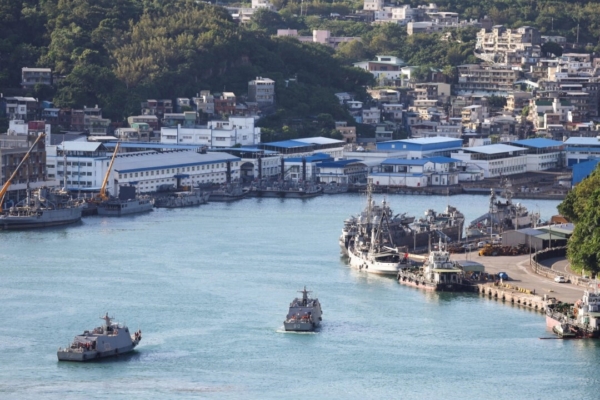Recently, Taiwanese President Lai Ching-te made a historic national mobilization speech vowing to resist external “annexation” and in another speech, refused to succumb to the Communist Party of China’s (CCP) military erosion from across the strait, stating that a country under the CCP’s rule is “impossible” to become Taiwan’s “motherland.”
It is clear that determination and decisiveness can prevent and deter conflicts, while ambiguity, especially without overwhelming support, can lead to conflict. Undoubtedly, the views of the Taiwanese President are not ambiguous.
Many defense scholars in the United States frequently point out Taiwan’s lack of readiness. Randall G. Schriver, who served as Assistant Secretary of Defense for Indo-Pacific Security Affairs during the Trump administration, believes that Taiwan should take measures such as “better training of reserve forces.”
Currently, the requirements for reservists are quite low, such as firing guns a few times a year. Strengthening reservists will indeed be helpful, while also ensuring that limited funds are spent on the right things, such as military systems and platforms suitable for all stages of conflict, including coercion and gray area tactics, as well as anti-invasion capabilities. Additionally, training, logistics, and maintenance are also crucial.
President Lai Ching-te has transformed feedback into action by establishing the “Whole-of-Society Defense Resilience Committee” and mobilizing 400,000 civilians to be prepared to face any military conflict at any time.
President Lai Ching-te’s introduction of this plan is a form of “soft” mobilization, drawing lessons from Ukraine’s resistance to Russian invasion. The plan aims to mobilize a vast number of civilians willing to assist in resisting foreign occupation or attacks, requiring concerted efforts from diplomatic missions, military forces, security departments, private sectors, civil society, and the general public.
On February 24, 2022, in the first few hours of Russia’s military invasion of Ukraine, Russian forces launched an assault on the Hostomel airport west of Kiev. This incident serves as a crucial example that inspired Taiwan’s national defense plan. In the ensuing month-long conflict, Russian paratroopers engaged in fierce battles with Ukrainian regular forces, National Guard units, reservists, and civilian militias hastily assembled joint forces. Ukraine’s resilient resistance forced surviving Russian forces to retreat by late March. Undoubtedly, such a whole-of-society mobilization model provided inspiration for Taiwan’s plan.
During my visit to Taiwan from September 6 to 14 this year, I met with officials and leaders from various government ministries and think tanks. Senior researchers at the Institute for National Defense and Security Research in Taipei, including Su Ziyun, Gong Xiangsheng, and Wang Zheren, expressed that Taiwan has the ability to defend itself in the short term: “We hope to be self-reliant and self-defensive without U.S. assistance.”
They emphasized that Taiwan does not want to appear to rely on or need the U.S. military to defend Taiwan. “All we ask is for the weapons and ammunition we purchase to be delivered. With all weapons in place, we can defend ourselves,” they said.
In response, Su Ziyun stressed that the Taiwanese people are not “desperate for life and afraid of death, seeking enjoyment.”
Recently, the Chinese military launched a ballistic missile from Hainan Island towards the South Pacific, 2000 miles south of Hawaii, further exacerbating international tensions. This launch is essentially unprecedented, with the last similar launch occurring in 1980, 44 years ago. This launch is likely a retaliatory measure against the historic joint statement made by the U.S. and the EU in support of Taiwan in September. The U.S.-EU statement rejected the outdated concept of “One China,” which is clearly out of touch with the current era.
In addition to China’s long-range ballistic missile launch towards the South Pacific, Taiwan’s Pave Paws long-range early warning radar detected that on September 25, the Chinese military launched intercontinental ballistic missiles (ICBMs), with several missile launches within China as well.
Given all these missile launches by China, Taiwan has declared a state of alert and has raised its harbors and airports to higher levels of readiness in preparation for potential missile attacks by the CCP regime.
Undoubtedly, the maritime and airport facilities around Taiwan are crucial for maintaining the island’s food, energy, and citizen mobility. If the Chinese military were to launch missile attacks on these facilities, the ongoing establishment of Taiwan’s whole-of-society defense resilience plan would allow for swift clearance of rubble for rescue operations, ensuring critical systems’ restoration, and providing medical services to the injured.
According to official announcements from Taiwan, the first batch of 400 American-made Harpoon long-range anti-ship missiles and their launchers arrived at Kaohsiung Port on September 27. These missiles possess strong deterrence capabilities, serving as a powerful complement to Taiwan’s existing stockpile of Hsuing Feng anti-ship missiles and ground attack missiles located in various positions in Taiwan, including fixed launch sites in mountainous regions, mobile launcher units, and air-launched missiles.
Taiwan has also successfully developed its own Tomahawk missiles, named HF-2. These missiles can penetrate deep into mainland China, targeting and threatening airports and naval bases within China. The American-made Harpoon missiles will be deployed at two to three new missile bases.
Taiwanese defense researchers have mentioned concerns about the possibility of China implementing a “blockade” strike against Taiwan in the next six months. The transport and deployment of Harpoon missiles are measures that any Chinese military or security isolation forces would attempt to prevent or seize. The “Whole-of-Society Defense Resilience” forces planned by President Lai Ching-te will enhance the island’s depth and capabilities to resist Chinese military threats.
Furthermore, strengthening Taiwan’s military reserve forces will enhance defense missile and other troop personnel equipment, improving readiness. All these elements combined can effectively replicate Ukraine’s advanced experience in resisting Russian military invasion.
(Note: The original article includes a biography of John Mills, retired Colonel of the U.S. Air Force and a national security expert. It also mentions his affiliation as a senior researcher at the Center for Security Policy in Washington, DC.)

